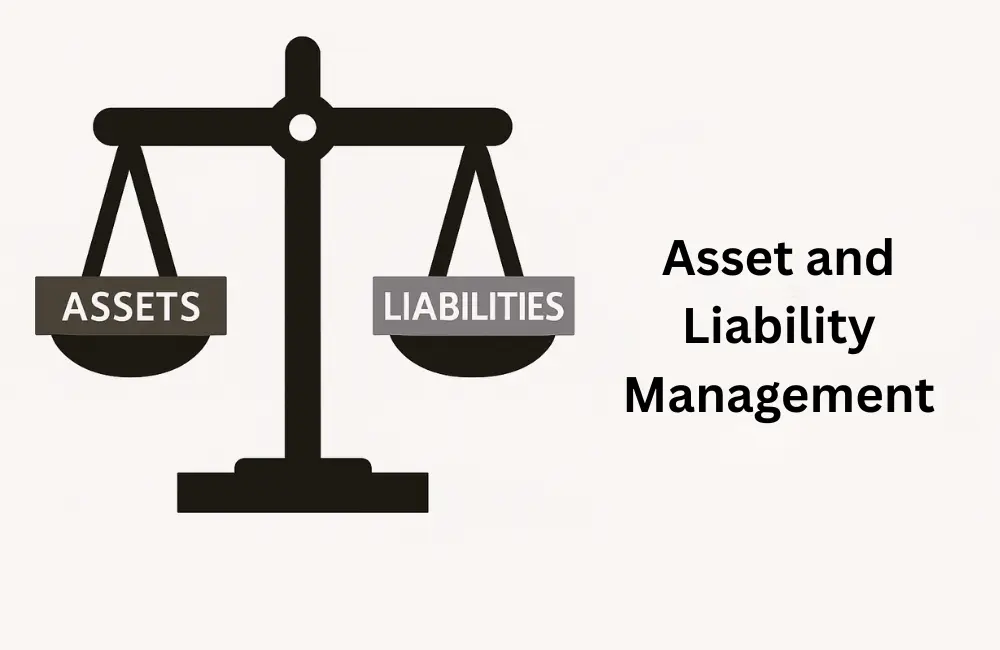In today’s unpredictable financial environment, managing risk isn’t just a best practice—it’s a necessity. Whether it’s a bank issuing long-term loans or an insurance company planning for future policy payouts, the balance between assets and liabilities can determine the survival and success of an institution. This is where (ALM) Asset Liability Management steps in. More than just a financial buzzword, ALM is a vital framework that helps organizations ensure their financial stability by aligning what they own (assets) with what they owe (liabilities). In this guide, we’ll explore the meaning, strategies, tools, and importance of ALM across sectors, showing why it’s become a cornerstone of modern financial risk management.
To Learn About: Do Digital Asset Management Systems Need a Database?

What is Asset Liabilities Management?
(ALM) Asset Liability Management is a strategic financial practice that helps banks, insurance companies, and large organizations manage risks from mismatches between their assets and liabilities. By aligning cash flows, maturity timelines, and interest rate exposures, asset liabilities management ensures financial stability, liquidity, and profitability. This process is vital for meeting regulatory standards, such as Basel III, and for avoiding risks related to interest rate shifts and funding gaps. Whether through traditional analysis or advanced asset liability management software, effective ALM enables institutions to proactively manage balance sheet risks and maintain long-term financial health.
To Learn About: What is CMMS Skills? & What is CMMS Experience?
Meaning of Asset Liability Management
(ALM) Asset and Liability Management is a comprehensive financial strategy that focuses on managing the risks arising from the interaction between an organization’s assets and liabilities. The core meaning of ALM lies in maintaining a balance between incoming cash flows from assets and outgoing payments related to liabilities. This balance is crucial for ensuring that financial institutions, especially banks and insurance companies, can meet their financial obligations without facing liquidity shortfalls or interest rate shocks. ALM involves analyzing the structure, timing, and behavior of both assets and liabilities to make informed decisions that support long-term stability and profitability.
Definition of Asset and Liability Management
Asset Liability Management can be defined as a coordinated financial risk management process that aims to align an institution’s assets and liabilities in terms of maturity, interest rate sensitivity, and liquidity profile. It involves forecasting future cash flows, assessing exposure to interest rate and market fluctuations, and implementing strategies to mitigate these risks. The ultimate goal of ALM is to protect the organization’s economic value and ensure that liabilities are covered when they come due, all while maximizing returns within a defined risk tolerance. This definition underscores ALM’s role as a foundational tool in modern financial planning and regulatory compliance.
To Learn About: Web Based CMMS Software
Importance of asset and liability management in Financial Institutions
Financial institutions operate in environments characterized by fluctuating interest rates, changing regulatory landscapes, and evolving market dynamics. ALM serves as a vital tool in navigating these complexities by:
- Risk Mitigation: ALM helps in identifying and managing risks associated with interest rate changes, liquidity shortages, and capital inadequacies.
- Regulatory Compliance: Institutions must adhere to regulatory requirements such as Basel III, which emphasize the importance of maintaining adequate capital and liquidity buffers.
- Profitability Enhancement: By optimizing the balance between assets and liabilities, institutions can improve their net interest margins and overall profitability.
- Strategic Planning: ALM provides insights into future financial positions, aiding in strategic decision-making and long-term planning.
Core Components of Asset Liability Management
ALM encompasses several key components that collectively contribute to effective risk management:
- Interest Rate Risk Management: Monitoring and managing the impact of interest rate fluctuations on assets and liabilities to protect net interest income.
- Liquidity Risk Management: Ensuring the institution has sufficient liquidity to meet its obligations without incurring unacceptable losses. Investopedia
- Capital Management: Maintaining adequate capital levels to absorb potential losses and support business growth.
- Funding and Investment Strategies: Developing strategies for sourcing funds and investing in assets that align with the institution’s risk appetite and return objectives.
Asset and Liability Management Techniques and Tools
Various techniques and tools are employed in ALM to analyze and manage risks effectively:
- Gap Analysis: Assessing the difference between the maturities of assets and liabilities to identify potential mismatches.
- Duration Analysis: Measuring the sensitivity of assets and liabilities to interest rate changes to manage interest rate risk.
- Scenario Analysis and Stress Testing: Evaluating the impact of hypothetical adverse scenarios on the institution’s financial position.
- Value at Risk (VaR): Estimating the potential loss in value of assets and liabilities under normal market conditions over a specific time frame.
Role of Asset Liability Management in Banks
In the banking sector, ALM plays a pivotal role in ensuring financial health and regulatory compliance:
- Balance Sheet Management: Aligning the composition of assets and liabilities to optimize returns and manage risks.
- Liquidity Management: Maintaining sufficient liquidity to meet withdrawal demands and other obligations.
- Interest Rate Risk Management: Protecting net interest income from adverse movements in interest rates.
- Capital Adequacy: Ensuring the bank holds adequate capital to absorb potential losses and support growth.
Banks often establish Asset Liability Committees (ALCOs) to oversee ALM activities and make informed decisions regarding risk management strategies.
Asset and Liability Management in Insurance Companies
Asset and Liability Management is equally critical in the insurance sector, where long-term liabilities, such as life insurance claims or annuities, require precise forecasting and matching with appropriate assets.
Key Considerations in Insurance ALM:
- Long-Term Liability Matching: Insurers must ensure that investments generate returns over a timeline that matches their payout obligations.
- Investment Strategy: Fixed-income securities like government bonds are often preferred for their stability and predictable yields.
- Risk Mitigation: Changes in interest rates and inflation significantly impact the present value of liabilities and the performance of fixed-income assets.
For example, if an insurer expects to pay out $100 million in 20 years, its ALM strategy would involve investing in assets that will mature or produce sufficient returns to meet that obligation, minimizing the gap between asset value and liability requirements.
Best Asset-Liability Management Software Tools
Given the complexity of ALM, using robust software is essential for automation, precision, and compliance.
Top Asset Liability Management Software Solutions:
- Moody’s Analytics: Offers integrated risk and ALM management platforms that support stress testing, liquidity modeling, and compliance.
- Oracle Financial Services ALM: Provides scenario-based modeling and analytics for interest rate risk and liquidity risk.
- QRM (Quantitative Risk Management): Widely used for balance sheet management in banks, offering tools for dynamic forecasting.
- MORS Software: Recognized for user-friendly dashboards and regulatory compliance features, especially in the European financial sector.
Benefits of ALM Software:
- Real-time analysis and scenario planning
- Regulatory reporting aligned with Basel III and IFRS standards
- Enhanced risk visualization and control
- Seamless integration with core banking or ERP systems
By deploying advanced asset liability management software, institutions can proactively manage potential mismatches and strengthen their financial strategy.
Asset Liability Management Training and Certifications
Professionals aiming to master ALM principles should consider specialized training and certification programs that align with the latest regulatory and industry standards.
Why ALM Training Is Essential:
- Improves technical proficiency in risk models, forecasting, and regulatory compliance.
- Enhances understanding of market dynamics and how they affect balance sheets.
- Offers recognition through certifications that validate expertise and commitment.
Top ALM Training Programs:
- Corporate Finance Institute (CFI): Offers comprehensive modules on financial risk and ALM.
- Global Association of Risk Professionals (GARP): Provides certifications like FRM that include ALM components.
- Moody’s and S&P Training Services: Focused courses on interest rate risk, liquidity strategies, and capital planning.
- Banking Academies in Europe and Asia: Regional courses tailored to local regulations and markets.
Pursuing asset-liability management training builds the credibility of finance professionals and aligns team capabilities with institutional goals.
Major Challenges in Asset-Liability Management
While ALM provides a framework for sound financial planning, it comes with notable challenges, particularly in today’s volatile and regulated environment.
Common ALM Challenges:
- Data Silos and Integration Issues: Disconnected systems can lead to inconsistent or inaccurate data.
- Interest Rate Volatility: Rapid shifts can disrupt matched positions, especially for fixed-income assets.
- Regulatory Complexity: Complying with different global standards (e.g., Basel III, IFRS 17, LCR/NSFR ratios) requires continuous system updates.
- Human Resource Constraints: The lack of trained professionals and analytical talent can hinder the effective execution of ALM strategies.
To combat these challenges, institutions are increasingly relying on AI-powered asset liability management software, hiring cross-functional teams, and engaging in continuous upskilling.
Best Practices for Effective Asset Liability Management
To succeed in ALM, institutions must go beyond compliance and integrate strategic foresight, governance, and technology.
Key Best Practices:
- Establish an ALCO: A dedicated Asset Liability Committee ensures continuous oversight and accountability.
- Adopt Integrated Risk Management: Align ALM with other risk functions such as credit, operational, and market risk.
- Automate Reporting: Use technology to generate real-time dashboards and regulatory submissions.
- Conduct Regular Stress Tests: Evaluate the balance sheet under extreme but plausible conditions.
- Align ALM with Business Goals: Balance profitability with resilience by embedding ALM into strategic planning.
These best practices help institutions build confidence with regulators and stakeholders while protecting long-term financial health.
FinTech and AI in Modern Asset-Liability Management
The financial industry is rapidly adopting new technologies to enhance ALM operations.
How AI and FinTech Transform ALM:
- Predictive Modeling: Machine learning algorithms can forecast market behavior and detect early warning signs.
- Automated Decision Making: AI reduces manual intervention by suggesting rebalancing strategies based on real-time analytics.
- API-Based Integrations: FinTech platforms easily connect with existing ERPs and risk engines to streamline workflows.
Innovations like real-time liquidity monitoring, behavioral modeling of cash flows, and AI-driven scenario testing are redefining ALM asset and liability management in the digital age.
Real-World Case Studies of Asset and Liability Management
Case 1:
HSBC employs an advanced ALM framework across its global operations. It uses AI-driven tools to simulate various interest rate and liquidity scenarios, helping the bank meet global regulatory requirements and optimize its balance sheet.
Case 2:
AXA’s ALM team integrates ESG metrics into its investment and liability strategies. They use long-dated sovereign bonds and alternative assets to match policyholder obligations, ensuring stable returns and capital efficiency.
These examples highlight the real-world impact of integrating strategic asset and liability management with innovation and governance.
The Future of Asset Liability Management
ALM will continue evolving in response to new regulatory, technological, and market developments.
Key Trends to Watch:
- ESG Integration: Environmental and social risks will increasingly influence investment and funding strategies.
- Real-Time Risk Dashboards: Institutions will shift to live ALM monitoring rather than monthly or quarterly updates.
- Regulatory Automation: Supervisory technology (SupTech) will automate compliance testing and submissions.
Staying ahead in ALM means investing in the right people, platforms, and policies today.
Conclusion
Asset liability management is the cornerstone of financial risk management for institutions across the globe. With increasing complexity in global markets, interest rates, and regulation, the need for precise, tech-enabled, and well-governed ALM has never been greater.
By aligning liabilities with appropriate assets, integrating technology, investing in training, and following best practices, institutions not only mitigate risk but also position themselves for strategic growth.
To Learn About: Ultimate Guide to Preventive Maintenance Checklists for CMMS
Frequently Asked Questions
Asset liability management (ALM) is the process of managing financial risks arising from mismatches between an organization’s assets and liabilities, particularly related to interest rates, liquidity, and capital adequacy.
ALM ensures these institutions can meet future obligations while maintaining profitability, regulatory compliance, and capital efficiency.
Common tools include gap analysis, duration matching, scenario and stress testing, value at risk (VaR), and ALM software platforms like Moody’s or Oracle.
AI helps forecast risks, simulate scenarios, automate compliance, and improve decision-making in ALM strategies.
Recommended certifications include FRM by GARP, CFI’s ALM course, and programs from Moody’s and leading business schools.
